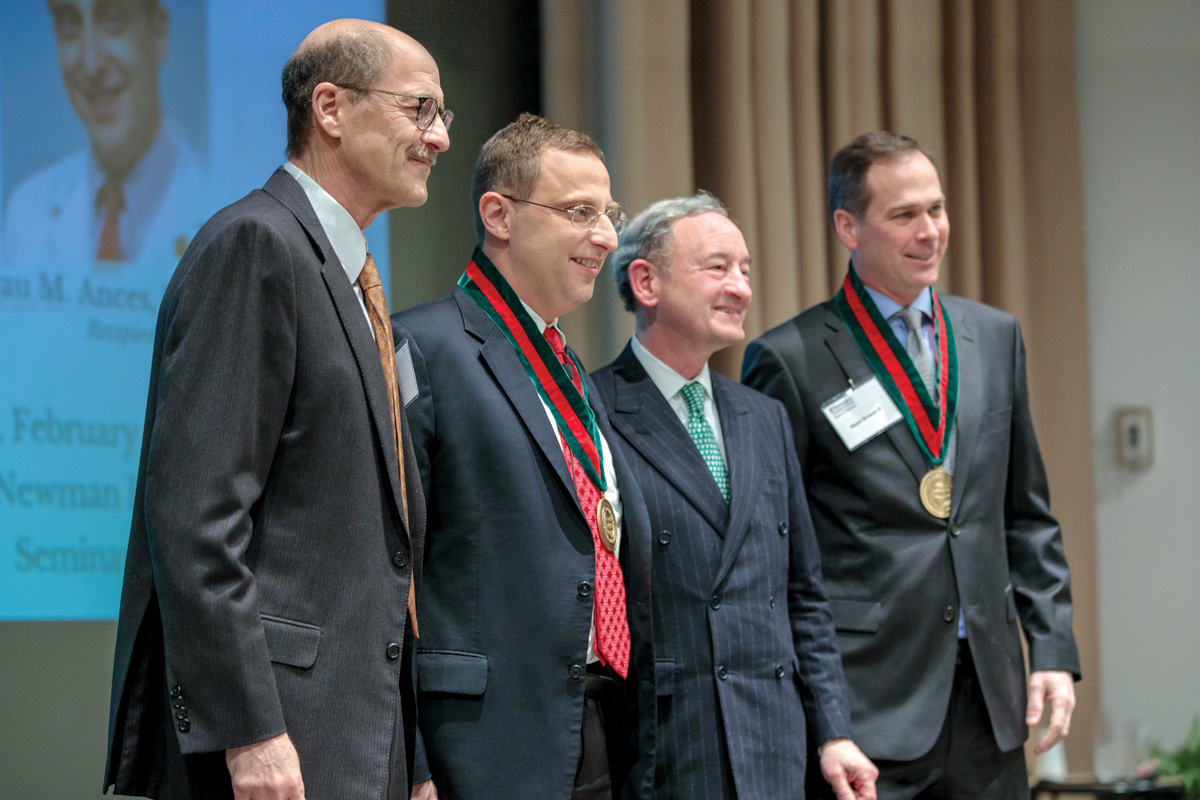
Beau Ances, MD, PhD, MSc, second from left, becomes an endowed professor. Joining in on the celebration are (from left): David H. Perlmutter, MD, executive vice chancellor for medical affairs and dean of the School of Medicine; Chancellor Mark S. Wrighton; and Daniel J. Brennan II.
A bequest by the late Daniel J. Brennan, MD, is supporting significant advancements in Alzheimer’s disease research at the School of Medicine. The disease affects 5.5 million Americans — a number expected to climb rapidly as people live longer.
Following Brennan’s death in 2010, the estate gift created the Daniel J. Brennan, MD, Research Fund in the Charles F. and Joanne Knight Alzheimer’s Disease Research Center (Knight ADRC). In 2017, at the family’s request, a portion of the gift was used to establish the Daniel J. Brennan, MD, Professorship in Neurology, further extending its impact.
Born in St. Louis, Brennan trained at Saint Louis University — earning undergraduate and medical degrees and completing a general surgery internship and residency and a plastic and reconstructive surgery residency. A gifted plastic surgeon, Brennan practiced at St. John’s Mercy Medical Center (now Mercy) until 1997 as a member of Plastic Surgery Affiliates.
As a longtime benefactor of medical education and research, Brennan chose Washington University School of Medicine for his estate gift because of its national leadership in Alzheimer’s disease research.
Brennan’s son, Daniel J. Brennan II, said the gift reflects the things his father valued in his own career. “My father dedicated most of his adult life to medicine — and caring for people,” he said. “It was his passion. To have his name associated with such a prestigious university, and a leader of Alzheimer’s research, fits with his desire to leave a mark. It also fits with his desire for excellence.”

John C. Morris, MD, director of the Charles F. and Joanne Knight Alzheimer’s Disease Research Center, performs a neurological exam on a patient. A long-term study of adult children of Alzheimer’s patients aims to define who is likely to develop the disease.
Uncovering the progression
John C. Morris, MD, the Harvey A. and Dorismae Hacker Friedman Distinguished Professor of Neurology, leads the Knight ADRC, located in the Department of Neurology. The center and its clinical research arm — the Memory and Aging Project (MAP) — are at the forefront of a worldwide effort to uncover key causal factors in Alzheimer’s disease and improve early diagnosis, with a goal of finding more effective treatments, an eventual cure or even preventing the illness entirely. The researchers believe that beginning preventive treatment before brain damage occurs is essential to halting disease progression.
Morris leads a team focused on improving early-stage diagnosis, identifying preclinical stages of Alzheimer’s disease by biomarker and neuroimaging studies, evaluating new drugs for the treatment of dementia and establishing phenotypes for inherited forms of Alzheimer’s disease and other dementias. Volunteer research participants, including those who are aging normally and those with dementia, and family members have been major contributors. They take part in annual assessments through the MAP and various other studies, such as clinical drug trials, and provide biological and imaging specimens.
Morris also is the principal investigator of the Adult Children Study, a long-term study of adult children of Alzheimer’s patients — led by the School of Medicine — that aims to define who is likely to develop the disease and when, and to establish a timeline for how quickly the disease will progress. The study, which began in 2005 with funding from the National Institute on Aging of the National Institutes of Health (NIH), already has helped identify some of the molecular and structural changes in the brain that occur in the decades before a person is diagnosed with the neurodegenerative disease.
Fulfilling a legacy
According to Dan Brennan II, establishing a professorship was an important step in fulfilling his father’s wishes.
“As long as I can remember, he spoke of a desire to have an endowed professorship in his name as part of his legacy,” he said. “And I’m proud to have my daughters — Mackenzie, Livia, Danielle and Sylvia — involved and witness the impact of the legacy that my father has left behind.”
In February, neuroimaging expert Beau Ances, MD, PhD, MSc, was installed as the inaugural Daniel J. Brennan, MD, Professor of Neurology. Ances is a professor of neurology, neurosciences and molecular microbiology and microbial pathogenesis at the School of Medicine and of biomedical engineering at the School of Engineering & Applied Science. He also is a member of the Knight ADRC and the Hope Center for Neurological Disorders.
The Ances lab has been at the forefront of developing novel neuroimaging methods to understand the timeline of change seen in both sporadic Alzheimer’s disease and autosomal dominant Alzheimer’s disease. The vision of the Ances lab is to find neuroimaging biomarkers that will allow for Alzheimer’s disease diagnosis and evaluate the efficacy of potential therapies.
While Alzheimer’s research primarily has focused on the accumulation of the protein amyloid beta, researchers now are paying closer attention to another protein, tau. Long associated with the disease, tau is not easy to visualize through imaging and, as a result, has not been thoroughly studied.
Using a new binding agent that makes tau protein visible on positron emission tomography (PET) scans, Ances and his colleagues have shown that measures of tau are better markers of the cognitive decline characteristic of Alzheimer’s than measures of amyloid beta protein. This allows for a better understanding of Alzheimer’s progression.
Published in the Summer 2018 issue






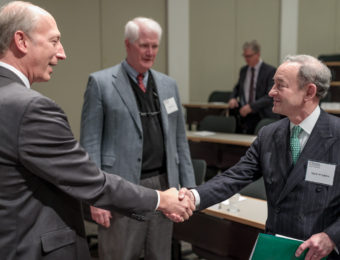





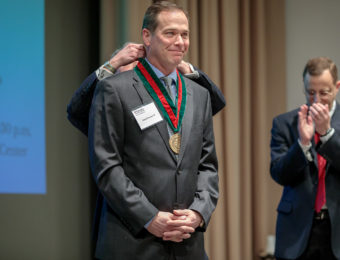

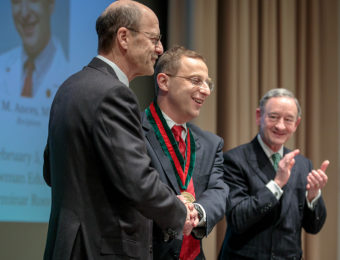
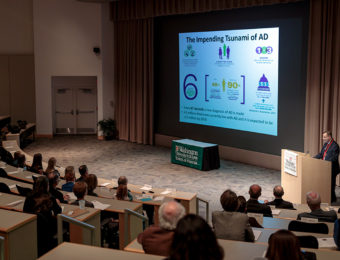

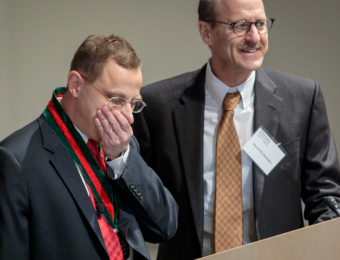
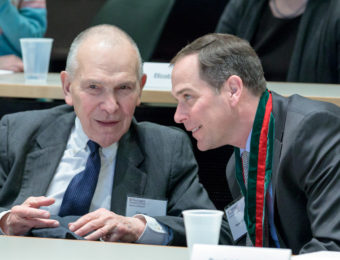
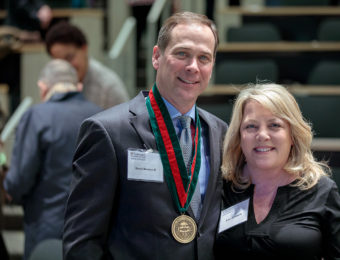
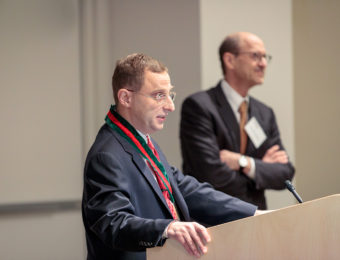
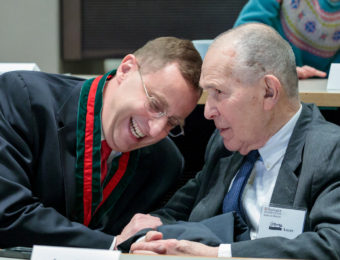
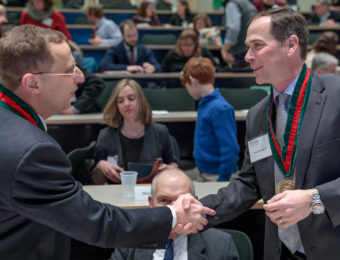
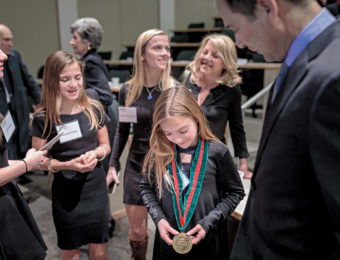

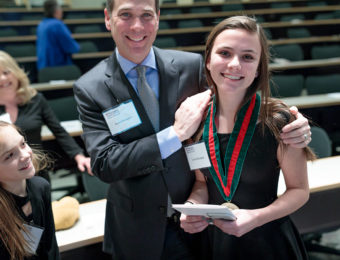
 Share
Share Tweet
Tweet Email
Email